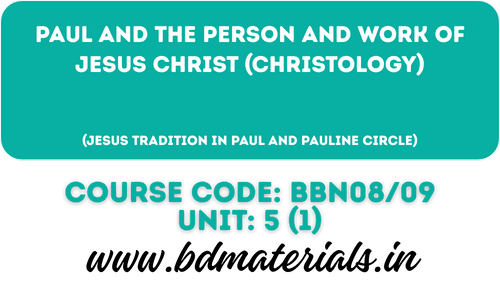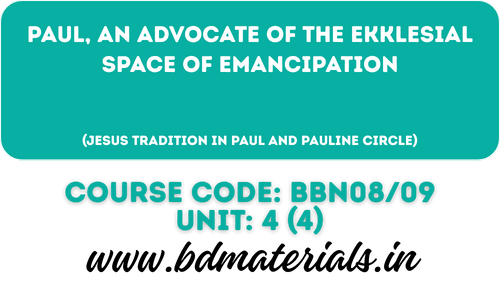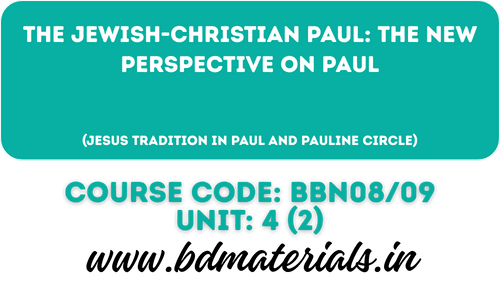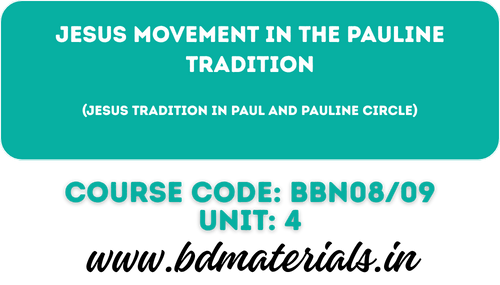Paul and the Person and Work of Jesus Christ (Christology)
Introduction
Paul‟s presentation of Jesus Christ differs in unessential way from the presentations in the Gospels. The vital difference was made by the resurrection of Jesus. The unfolding of the suffering Messiah in the Gospels becomes the triumphant living Christ of the epistles. When Paul wrote about Jesus Christ, the messianic mission was accomplished. He develops his own reflections on the new-look messianic concept, which found fulfilment in the risen Christ, who inaugurated a spiritual kingdom. The essence of Paul’s view of Christ lies in the assertion that God has made Christ the victor over the power of sin.[1] Therefore, in this paper, the study will be focusing mainly on Christological titles, Christ, Son of God, and Son of man, and the Lord.
1. Christological Titles
1.1. Christ/Christ Jesus – Emphasis on Divinity of Jesus
The term Christos is the most frequent title applied to Jesus by Paul. In the genuine Pauline letters, it occurs some 270 times. Paul‟s references to Jesus as “Christ” serve to remind readers of Jesus‟s humanity, especially His role as the Jewish Messiah. When Paul listed for the Romans some distinctive privileges of Israel as the people of God, he concluded by noting that “from them is traced the human ancestry of Christ‟‟ (Rom 9:5; Eph 22:12). This affirmation was also made earlier in the letter (Rom 1:3) when Paul connected his proclamation of the gospel with the fulfilment of promises regarding Christ made by Old Testament prophets. The fulfilment of the prophetic statements about Christ was important to Paul because he found in them assurance for Israel‟s salvation. As he wrote later in this letter, Isaiah 59:20. The deliverer will come from Zion; he will turn godlessness away from Jacob (Rom 11:26). Paul looked forward to the day when Israel would receive Jesus as Christ. Paul takes the traditional uses of the title with respect especially to the death and resurrection of Jesus, he also uses it in many other ways. The distinct Pauline element came out in the use of the phrase „in Christ‟ by which Christ is described as determining circumstance which conditions the life of the believer. This means that the phrase does not refer so much to a mystical union with a heavenly figure but rather to the historical facts of the crucifixion and resurrection which condition our existence. Thus, justification takes place „in Christ‟ (Gal 2:7).[2]
1.2. Son of God
As in the Gospels, the expression „Son of God‟ primarily identifies Jesus role as the Representative of God who faithfully carries out His will. But in contrast to the Gospels, the emphasis is less on Jesus‟ humble submission and obedience in fulfilling God‟s will and more on Jesus‟ exalted status as the one who carries out God‟s work in the present era. Paul, for example, said that Jesus was „declared with power to be the Son of God by his resurrection from the dead: Jesus Christ our Lord‟ (Rom 1:4). In this sense the designation „Son of God‟ is similar in meaning to the title „Lord.‟ Both are linked with the authority Jesus exercises as the representative of God the Father in the present era. As Paul told the Corinthians, „he must reign until he has put all his enemies under his feet‟ (1 Cor 15:25).[3]
1.3. Lord
In the Old Testament, Lord is a common designation of God. In the New Testament this title is routinely given to Jesus as the Provider of salvation. Paul applied to Jesus in Romans 10:13, „Everyone who calls on the name of the Lord shall be saved‟. The confession „Jesus is Lord‟ is used by Paul as a summary statement faith for those saved: „If you confess, „Jesus is Lord and believe in your heart that God raised him from the dead, you will be saved‟. (Rom 10:9). Similarly, when he told the Corinthians that “no one can say, „Jesus is Lord.‟ except by the Holy Spirit” (I Cor 12:3). He was not denying the possibility of false profession. Also associated with the idea of Jesus as Lord, is a recognition of his authority over people. Christians must take account of Jesus‟ lordship. The universal dimensions of His rule will be seen when “he has destroyed all dominion authority and power. For he must reign until he has put all his enemies under his feet” (1 Cor 5:24 b25). Then the distinctive lordship of Jesus will come to an end and “the Son himself will be made subject to him who put everything under him so that God may be all in all” (v. 28).The majority of Paul‟s uses of „Lord‟ for Jesus relate to the present or to future. Rarely does Paul look Walt of Jesus as Lord : as ready noted he does not speak of „the Lord dying‟ or „the crucified Lord‟. He does. However, frequently refer to Jesus‟ coming in the future in terms of Jesus as Lord. For example, in First Thessalonians 4:13-18, Jesus is referred to as „Lord‟ five times in quick succession; and in First Corinthians 16:22 the Aramaic Maranatha invocation is used by Paul to pray for the Lord to come.”[4]
1.4. Last Adam
Paul referred only once to Jesus as “the last Adam”. However, he did compare and contrast Christ and Adam at different times in Romans and I Cor. When he described as the last Adam, Christ as “the last Adams”. In Corinthians, the adjective “last” underscores the difference between the two men. Paul viewed Adam as the one whose act of disobedient brought sin and death to all people (Rom 5:12, I Cor 15:21-22). The focus of discussion in I Cor is the resurrection. Earlier in the passage Paul has contrasted the effect of Adam and Christ on humanity. “For since death came through a man, the resurrection of the dead comes also through a man. For as in Adam all die, so in Christ will all be made alive” (v. 2l-22). This contrast is continued in Paul‟s reference to Christ as the last Adam. The first man Adam became a living being the last Adam a life-giving spirit” (v. 45). Just as Adam was an earthly man who brought death to all those associated with him (v. 22a), Christ is a heavenly Man who brings life to all those connected with Him (v. 22b). Adam represents the first creation, formed by God from the dust of the earth (v. 47a). Christ represents the new creation, those resurrected by God’s power.[5]
1.5. The Significance of the Resurrection
Paul considers the historical appearances of the risen Christ to be essential as an introduction to his general discussion of the resurrection theme in l Corinthians 15. In this discussion Paul goes as far as to say that faith would be fruitless if Christ were not risen (l5:l7). The whole idea of salvation from sin would be abolished. The resurrection stands, therefore at the Centre of Paul‟s theology as well as at the Centre of his experience. For Paul, Christ‟s resurrection was God‟s affirmation that Jesus‟ death did indeed pay the penalty for sin. As he told the Corinthians, “lf Christ has not been raised, your faith is fruitless; you are still in your sins” (I Cor 15:17). This same point was made concisely when he said that Christ “was delivered over to death for our sins and was raised to life for our justification” (Rom 4:25). The resurrection testified to the fact that Jesus‟ death made possible freeing from sin‟s penalty, escape from sin‟s power, and ultimate deliverance from sin‟s presence. Jesus‟ resurrection also initiated His role as Lord. He now exercises authority at God‟s right hand, “Christ Jesus, who died more than, that, who was raised to life is at the right hand of God and is also interceding for us.” (v. 34b).
Paul also regarded Christ‟s resurrection as typical of what Christians will experience. “Christ has indeed been raised from the dead, the first-fruits of those who have fallen asleep” (I Cor 5:20). In a similar vein he wrote to the Romans. “And if the Spirit of him who raised Jesus from the dead is living in you, he who raised Christ from the dead will also give life to your mortal bodies through his Spirit, who lives in you.” (Rom 8:11) The resurrection is then not so much a work that Christ did as it is a work of God the Father and the Spirit. Yet Paul regarded the resurrection as integrally related to Jesus‟ present ministry and an essential aspect of Christian‟s future experience.”[6]
1.6. Christ as the Image of God
Paul also describes Jesus Christ as “the image of„God.” (2 Cor 4:4; Col l:l5; Rom 8:29). Such a formulation hearkens back to Genesis l:27, where Adam (and Eve) is made “according to the image of God”. We often think of an image as an imperfect or lifeless copy of the original, but Paul understands the image to partake of the reality and the nature of the original. The special role which Christ has in salvation as the image of God is the role which he played in creation. “He is the image of God of the invisible God, for in him all things in heaven and an earth were created, and through him God was pleased to reconcile to reconcile to himself all things through the blood of his cross” (Col l: l5-20). Humans as created according to God‟s image consists in the call to rule over the created world (Gen l:26), but the beneficent rule of Adam and Eve was mined by the fall. Instead of bringing joy and peace to the world, they introduced thorns and this little (Gen 3:17-19) and the created world was subject to frustration and vanity (Rom 8:19-22). Human beings born in Adam would never bring about a world of joy and goodness since they too have sinned (Rom S: l2-l9). Jesus the Messiah, however succeeded where Adam failed. Through him God‟s plan to bring the world under his lordship will succeed. Paul did not only identify Jesus as the second Adam, nor does he compare Adam and Jesus in every respect. Adam was created “according to the image of God” (Gen 1:27), but Jesus “is the image of God” (2Cor 4:4: Col l:l5). Christ as the image of God surpasses Adam because the word image suggests that he shines the very nature of God. He represents God himself to the world because he partakes in the very essence of God. Jesus is not only the second Adam; he is also the agent of creation and the goal of creation.[7]
Only through Jesus Christ, the one and only image of God can human beings attain what God intended in making Adam according to his image. It is interesting to see, therefore, the close conjunction between “the new man” and being restored to “knowledge according to the image” in Colossians 3:l0. People are restored to the fullness of God‟s image through a saving knowledge of God, and such saving knowledge becomes a reality through Jesus (II Cor: 3:18, Eph 4:24). Indeed, those who are “conformed to the image of his Son.” (Rom 8:29) are predestined by God to share in this joy. He is not image in the sense of a reprduction or likeness, but in the sense of essence. Therefore, we can know who God is by knowing Christ.[8]
1.7. Kenotic Christology: Christ Emptied Himself (Phil 2:5-11; II Cor 8-9)
Christ Jesus, before his incarnation, was equal to God and displayed the splendour of God’s Glory. When he came into the world, however, he did not take advantage of these privileges. He subjected himself to humiliation for the sake of human beings (2 Cor 8:9). The contrast of Jesus with Adam is striking since Adam in the garden strove to be equal to God and thus rejected God‟s lordship in eating of the fruit of the tree. Christ, on the contrary, though possessing equality with God did not use his status as a means of enriching himself. Indeed, precisely because he was in the form of God and was equal with God, he refused to use his position as a mains of self-aggrandizement. He used his status as a platform for giving and self-surrenders, not as a bridgehead for praise and self-exaltation. The cross, not the crow, was his path to glory. The nature of Christ‟s humiliation is also the subject of controversy. What does Paul have in mind when he says that “Christ emptied himself”? Some have understood this to mean that he surrendered himself completely of his deity in becoming a human being. Close attention to the text is necessary to discern Paul‟s meaning. The main verb he emptied (ejkenosen) is modified by two participles: taking (labon) and becoming (or being made-genomenos). That is, he emptied himself by taking the form of a servant and by being made in the likeness of human beings. The emptying of Christ, then, consisted of an adding. He emptied himself by becoming fully human. The text does not say that he emptied himself by surrendering his deity; it says that he humbled himself by adding humanity.[9]
2. ‘Binitarian’ Devotion
Binitarianism is a Christian theology of two persons, personas, or two aspects in one substance/Divinity (or God). Classically, binerianism is understood as form of monotheism that is, that God is absolutely one being; and yet with biniterianism there is a “twoness” in God, which means one God family. The other common form of monotheism is “unitarianism”, a belief in one God with three persons.[10] Scholars recognize that the reverence for Chriist reflected in Paul‟s letters amounts to a notable pattern of beliefs and devotional practices for which we have no real parallel in Roman-era Jewish tradition. Some scholars conclude that we can speak of a novel „binitarian‟ devotional pattern evident in the Pauline letters, Christ included with God as recipient of devotion in early Christian circles, although Christ always functionally subordinate to God „the Father‟. But some other scholars contend that this is an exaggeration of things and that the reverence of Christ in Paul, though impressive, does not amount to worship and was not then seen as quite the innovation in monotheistic commitment that is alleged by other scholars. In either view, however, the devotion to Christ manifest in Paul‟s letters is a major development in religious history.[11]
3. Paul as Innovator
Some scholars portray Paul as very much an innovator in his Christology, but other note how little evidence there is in his letters that his Christological views were contentious to other Christians. To be sure, there is evidence that Paul was controversial, as shown particularly in the epistle lo Galatians. But here and elsewhere in his epistles (e.g. 2 Corinthians 11) I lie controversies have to do basically with his validity as an apostle and whether, as Paul proclaims, Gentiles are excused from Torah-observance. In other Jewish Christians Paul defends his Gentile mission by invoking Christological convictions that are shared by them (eg. Gal. 2:1l-l6). Certainly, it appears that he drew implications from these shared convictions that were not seen so readily by others. But, apart from the defence of his gospel of Gentile salvation, Paul shows little indication that his Christological convictions were innovative or controversial among the Christians he knew. If this is correct, then his letters are in a sense all the more historically important as reflections of Christological convictions widely characteristic of his churches and of at least a good many other Christians as well.[12]
Conclusion
We have seen that Paul‟s Christology is very rich and diverse. He can speak Jesus as a very human figure and indeed, much of his soteriology demands that Jesus be fully and completely human; as the new Adam, he is the one who for the first time relates to God in the way human beings should do and won created to do. As such, he becomes the source and focus of the new humanity. Yet Paul also clearly makes some very exalted claims about Jesus, He is the Lord, exalted to a unique position of power and authority to God‟s right hand; he is the embodiment of the divine Wisdom itself, and Jesus perhaps can be spoken of as pre-existent. As Son of God he is supremely obedient to God: he has the power of enabling other Christians to be „sons‟ and „daughters‟ of God. But it is also the case that his Son ship is qualitatively different ftom the Son ship of other Christians. Paul‟s epistles we have not only his testimonies of his Christological beliefs and the piety in which they fitted, but also invaluable historical evidence of the rapid Christological development that characterized the Christian movement in the earliest years. By the time of Paul‟s undisputed letters, written some twenty to thirty years from the death of Jesus, a veritable explosion in Christological convictions had taken place. In his conversion to the Christian movement, Paul not only assented to a set of Christological beliefs, but became a passionate advocate of them. His epistles are remarkable evidence of the intensity of the Christ-devotion that Paul practiced himself and promoted among his churches.
Bibliography
The Cambridge Companion to St. Paul, Edited by Dunnjames D.G, CAMBRIDGE UNIVERSITY PRESS, 2003.
Capes, D.B. Old Testament Yahweh Texts in Paul’s Christolog. Tubingen: Mohr Siebeck, 1992.
Kreitzer, L.J, Jesus and God in Paul’s Eschatology, JSNTS 19. Sheffield: Sheffield Academic Press, 1994.
Tunchapbo, Jesus Tradition in Paul and Pauline Circle, Kolkata:ESPACE, 2015.
Guthrie,Donald. New Testament Introduction, revised edition, Downers Grove. Illinois: Intervasity Press, 1990.
Footnotes
[1] Tunchapbo, Jesus Tradition in Paul and Pauline Circle, (Kolkata:ESCAPE, 2015), p.94.
[2] Donald Guthrie, New Testament Introduction, revised edition, (Downers Grove, Illinois: Intervarsity Press, 1990), p. 432.
[3] Neil Richardson, Paul’s Language about God, JSNTS 99 (Sheffield: Academic Press, 1994), p. 272.
[4] Neil Richardson, Paul’s Language about God, JSNTS 99 (Sheffield: Academic Press, 1994), p. 273.
[5] L.J. Kreitzer, Jesus and God in Paul’s Eschatology, JSNTS 19 (Sheffield: Sheffield Academic Press, 1984), p.23.
[6] L.J. Kreitzer, Jesus and God in Paul’s Eschatology, JSNTS 19 (Sheffield: Sheffield Academic Press, 1984), p.21.
[7] D. B. Capes, Old Testament Yahweh Texts in Paul’s Christology, (Tubingen: Mohr Siebeck, 1992), p. 57.
[8] Ibid…,58.
[9] Tunchapbo, Jesus Tradition in Paul and Pauline Circle, (Kolkata:ESCAPE, 2015), p.99.
[10] Ibid…,100.
[11] The Cambridge Companion to St. Paul, Edited by James D.G Dunn, (CAMBRIDGE: UNIVERSITY PRESS, 2003), p.196.
[12] The Cambridge Companion to St. Paul, Edited by James D.G Dunn, (CAMBRIDGE: UNIVERSITY PRESS, 2003), p.197.
Friendly Note
Greetings in the name of our Lord Jesus Christ! We are deeply thankful for your visit to BD Materials. It is our mission and joy to serve Bible students, pastors, and believers with high-quality theological resources that strengthen faith and understanding of God’s Word.
At BD Materials, you’ll find study notes, articles, question papers, and valuable academic content designed to support your biblical and theological education. We are dedicated to helping you grow in knowledge, ministry, and devotion to Christ.
We also invite you to explore our partner sites: Telugu Gospel Lyrics, featuring inspiring gospel song lyrics in Telugu, and Theological Library, a hub for Christian book summaries and devotionals.
Your encouragement means a lot to us! We invite you to share your study materials, articles, or insights with our community. Thank you for being part of this mission—may God bless your studies and ministry abundantly!






